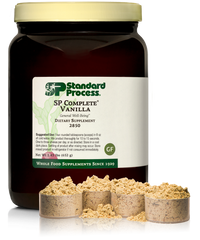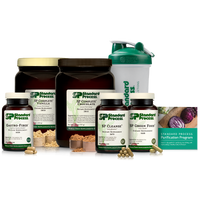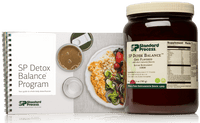
Whole Food Supplements vs Synthetic Vitamins
by Dr. Dave Wendel
Every year billions of dollars are spent on vitamin and mineral supplements which neither the consumer nor the retailer knows very much about. Most are inorganic and made from synthetic substances which do little if anything to improve overall health. Consumers know very little about how supplements are made; their characteristics, their attributes, what they are made from, their uses, theiradvantages, and disadvantages, or how to tell one from another by reading the label. So, what is the difference between natural and synthetic supplements? There is a huge difference between natural and synthetic supplements! Ultimately, it is the difference between something that is living and something that is dead.

Many conventional and non-conventional healthcare practitioners believe that a supplement is a supplement and that there is no difference between those made from living compounds or from synthetic materials. This is simply not true! Perpetuating this false information has led to enormous confusion in the nutritional field. Did you know that over 75% of medical schools do not have one course on nutrition in their curriculum. Just based on that, where and how do your medical providers get their knowledge on supplementation?
Heck, most do not even know what whole food supplements are and how they differ from the synthetic ones? How can medical providers know and offer their patients advice on supplements when there is little to no formal training on supplements, let alone on whole food supplements? I stress whole food supplements because the 98% that are made synthetically are not vitamin complexes and do not work to fix bodily functions.
The word NATURAL on vitamin labels has no specific definition other than that the substance exists somewhere on the planet or in outer space. Below we explain the three types of supplements.
WHOLE FOOD SUPPLEMENTS: The key words to look for are “Whole Food Vitamins.” This means that the vitamins found in the product are exactly as they are found in food, untampered with in any way. Using food in its original state ensures that the molecular structure is left intact, and the biological or biochemical actions will be consistent. Vitamins containing organically grown food sources are preferred since they are more nutrient-dense and contain no pesticide residues. They are also considered food because they contain all five components of food: vitamin complexes, minerals, active enzymes, proteins, and fats. At Shores Wellness Solutions we exclusively use whole food supplements.
CRYSTALLINE means that a natural food has been treated with various chemicals, solvents, heat, and distillations to reduce it down to one specific “pure” crystalline vitamin. In this process all the important synergists, which are termed and viewed as “impurities,” are destroyed. There is no longer anything natural in the action of crystalline “vitamins”—they should more accurately be called drugs. These are not living complexes because the vitamin complexes and enzymes have been destroyed, and they usually do not contain any proteins or fats.
SYNTHETIC means that a chemist attempted to reconstruct the exact structure of the crystalline molecule by chemically combining molecules from other sources. These other sources are not living complexes but are dead chemicals. For example, Vitamin B1 is made from a derivative of coal tar. Although naturally occurring, coal tar is not suitable for human consumption. Ascorbic acid (called Vitamin C by the FDA) is made by mixing corn syrup with sulfuric acid. Ascorbic acid is actually the outer wrapper of the whole vitamin C complex and is NOT vitamin C (similar to buying a candy bar and when you open the wrapper, nothing is inside it). Whole food vitamin C complex has eight components, and you need the full complex with all eight components to get the benefits of Vitamin C. These are just a couple of examples of synthetic vitamins.
Next to discuss is the difference between organic and inorganic minerals. The first question we want to explore is, is there a difference between these two? The fact is, there is a huge difference between organic minerals and inorganic ones! There are clues found on the labels. Most companies who manufacture vitamins and minerals obtain their raw materials from synthetic sources and these sources will not be listed on the label. If no source is given, you can safely assume the ingredients came from synthetic or unnatural sources. The following terms that are found on the labels can also help to identify a synthetic vitamin or an inorganic mineral. All of the following are nearly impossible to digest:
Acetate—a chemical compound used to make textile fibers or plastic.
Bitartrate—a crystalline acid from unripe grapes used as a food additive.
Chloride—compounds that contain chlorine and can lead to free radicals.
Oxide—compounds that contain oxygen and can lead to oxidation (excessive loss of electrons).
Hydrochloride—a solution that contains the liquid form of the very strong acid hydrochloric acid.
Nitrate—compound containing nitrogen that is very corrosive and poisonous and has strong
oxidizing properties, made solely in laboratories.
Succinate—an intermediate product in the function of glucose metabolism or synthesis.
Carbonate—a compound mixed with liquid carbon dioxide.
Do synthetic supplements function as well as whole food supplements? Absolutely not! No one would argue that complex, high-performance, equipment like computers or space shuttles require very specific, high-quality materials in order to function properly; however, living systems are even more complex and specific in their need for high-quality building materials. In addition, living systems are constantly breaking down and then rebuilding and repairing cells, tissues, organs, and systems. To complete this kind of complex process, the body must have a continual supply of high-quality material. If you build a house with cheap, imitation construction materials, your house will quickly fall into disrepair. The same is true for the physical body. The body is so incredibly intricate and complex that we have yet to even scratch the surface to understand it. The bottom line is that you can’t repair and rebuild a living body with dead chemicals. It simply is not possible.
Now that you have a basic understanding of whole food supplements versus synthetics or crystalline, a question that often comes up is, “How come I have to be on these [whole food] supplements for such a long time?” This is a really great question that I believe we really need to tackle. To explain why it is that you need to take whole food supplements for months, and sometimes years to truly fix a problem that the body is having, let me use the following example of calcium: The USRDA (United States Recommended Daily Allowance, which is the amount of a nutrient to keep us from having symptoms) for calcium intake is 1200 milligrams per day (mg/d). Let’s say that you are only consuming 1175 mg/d, only about 2% less than what you need daily. Not a big deal for a day, but now what happens if you do that for a year? Or worse, over a decade? Or even longer? In a year’s time you would be down over 9100 milligrams, almost 100,000 milligrams after just one decade!
Now, let’s say that you’ve been calcium deficient for a decade or two. Would you think that if I give you 100,000 milligrams in a day, or a week, or even a month, that your body will be able to absorb and utilize that excessive amount of calcium correctly to restore your calcium deficiency? Of course not! It will take time for that deficiency to correct itself. If it has been a decade or longer, you would have to consume an extra 250 mg of an absorbable form of calcium every day for well over one year, and that’s only if your body can absorb all that extra calcium. Which then brings up the question, “Can your body absorb an additional 250 mg of calcium per day over and above the 1200 mg it is supposed to have?” Probably not.
Next to understand, what is an absorbable form of calcium? An absorbable calcium is a calcium supplement such as Standard Process’s Calcium Lactate. This form of calcium is a vegetable source and once swallowed takes only one chemical reaction for it to move from your gut into your blood stream. Other forms of calcium such as citrate, carbonate, and malate to name a few, take between 15 - 18 chemical reactions before they can be absorbed, making it virtually improbable that they will be absorbed into your body. By not being absorbed, they act more like an anti-acid, decreasing your ability to digest foods.
This is just a quick blurb about calcium. Look at all the vitamin complexes, minerals, essential fats, enzymes, and proteins this way and you can understand why it takes time to rebuild a body. Nature intended that plants would eat the basic compounds, called soil. Plants have the ability to ingest soil, break it down, and detoxify it. Animals would then eat the plants, gaining the valuable nutrients that the plants unlocked from the soil. As humans, we eat both plants and animals, utilizing the valuable nutrient sources from them. When we ingest edible items that are not food, but man-made, it causes a depletion with the nutrients in our bodies. If we do this for too long, we create a deficiency within our bodies that will require whole food supplements to restore the missing nutrients.
Now if you are not taking whole food supplements, what are the ones you are taking actually made from? Synthetic vitamins are typically manufactured through chemical processes that often involve petroleum derivatives and other industrial chemicals. If you would like a more detailed look at how some common synthetic vitamins are made contact our office at support@ShoresWellnessSolutions.com, and type “Synthetic Vitamin Sources” in the subject matter.
Petrochemical derivatives and other industrial chemicals are the primary sources of crystalline and synthetic supplements. Various chemical reactions, such as hydrogenation, oxidation, and esterification, are used to create the desired fragmented vitamin compound. The advantages include cost-effectiveness because synthetic vitamins are generally cheaper to produce than natural ones, and a consistent potency. The disadvantages are that synthetic vitamins may not be absorbed as efficiently as their natural counterparts, synthetic vitamins often contain fillers, binders, and other additives, and their fragmented compound is not fully bioavailable, nor does it supply your body with a full vitamin complex.
At Shores Wellness Solutions we only use whole food supplements. The precursors to our supplements include organically grown vegetables and naturally raised animals. There is no heat or chemical processing to strip down or disrupt the nutrients and vitamins contained in our tablets and capsules, which is why we get great results! Still not too sure? Give our General Health Pack supplements a try for the next 60 days and experience the difference for yourself! If you are interested in discovering more about your health in a holistic manner, then schedule a consultation with us today.

































